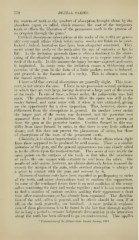Page 768 - My FlipBook
P. 768
778 DENTAL CARIES.
the crowns of teeth as the product of absorption brought about by tlie
absorbent organ, so called, which removes the root of the temporary
tooth or effects the liberation of the permanent tooth in the process of
its eruption through the gums.^
Cervical absorptions (absorptions at the necks of the teeth) are gener-
ally very small affairs which before caries results are liable to be over-
looked ; indeed, heretofore they have been altogether unnoticed. They
occur about the necks of the teeth after the age of maturity or late in
life. As the irritation proceeds there is often a tendency to the short-
ening of the gingival margin, in such a way as to expose more of the
neck of the tooth. In this manner the injury becomes exposed, and caries
is implanted. In many cases the irritation causes a thickening and
eversion of the gum in the form of a little pocket; caries is induced,
and proceeds to the fo>"mation of a cavity. This is oftenest seen on
the buccal surfaces.
I have said that cervical absorptions are generally slight. This, how-
ever, is not always the case. I have in my possession several specimens
in which they are very large, having destroyed a large part of the crown
of the tooth. In one of these, a lower molar, the pulp-cavity was laid
open. The granulation-tissue which filled the space was still in the
cavity formed, and came away with it when it was extracted, giving
me the opportunity for a close inspection. This, however, shoe's no
differences from the absorptions in general. In another lower molar
the larger part of the crown was destroyed, and the posterior root
separated from it by granulations that seemed to have grown in
from the gum at the posterior border. Cavities formed in this M'ay
differ from those formed by caries, in that there is very little softened
tissue ; and this does not present the phenomena of caries, but those
of absorptions of the roots of the })ermanent teeth.
Clinically, it is almost impracticable to divide these effects when slight
from those supposed to be produced by acid mucus. There is a similar
irritation of the gum, and the general appearances are very closely allied
as to the effects upon the tooth-structure. They occur at very nearly the
same points on the surfaces of the teeth, so that after the occurrence
of caries the one cannot with certainty be told from the other. The
results of acid mucus, however, are always distinctly below (toward the
crown) the margin of the gum, while cervical absorption is always at
a point in contact with the gum and covered by it.
Diseases of various sorts have been regarded as predisposing to caries
of the teeth, and many observations tend to confirm this supposition.
In some of the contiuued fevers there is an acid condition of the scanty
saliva continuing for days and weeks together ; and it is not uncommon
to find a number of carious cavities making their a])pearance a short
time after convalescence, as has already been explained. The distribu-
tion of the acid saliva is general, and its effects should be seen, if at
all, on the tectli generally, not localized. A more probable explana-
tion of these ])hen()mena is to be found in the fact that through neglect
for so long a ])eriod to remove lodgments fermentation in the interstices
about the teeth has been allowed to go on unobstructed. This applies
' Transactions of lite Illinois Stale Dental Society, 1884.


